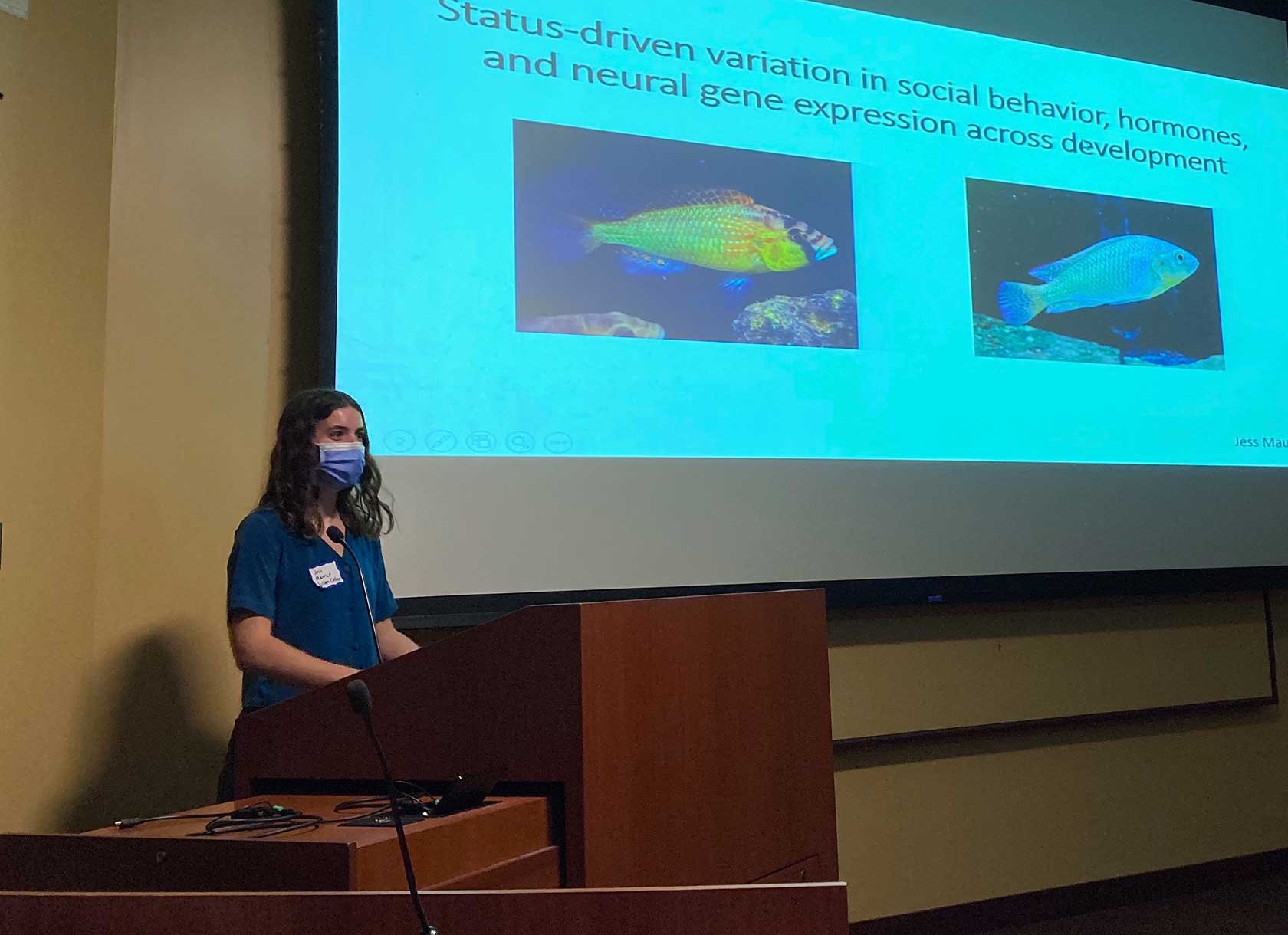
When neuroscience major Jess Maurice ’22 was asked to present her research at the Southern California Animal Behavior (SCAB) conference this spring, she jumped at the chance. For the past several years, Maurice has worked in Assistant Professor of Biology Tessa Solomon-Lane’s lab, advancing scientific understanding of animal social behavior. After months of conducting remote behavior analysis, the conference provided Maurice with the opportunity to share her findings in person with a broader community of animal behavior researchers.
“The experience of presenting at SCAB was very empowering,” Maurice says, adding that her focus on subordinate animal behavior influenced several conference attendees to consider applying this perspective to their own research. “It’s amazing to see the effect of novel scientific ideas and how collaboration advances science as a collective.”
“Researchers at the conference were very impressed by the scope of research that Jess carried out as an undergraduate,” Solomon-Lane notes. “This project highlights the best of doing scientific research at a liberal arts school.”
Examining the Formation of Social Hierarchies
Maurice’s research, which formed the basis of her senior thesis, explores the social hierarchies of fish, specifically the highly social Burton’s Mouthbrooder from the African cichlid family. Adult male cichlids change their visible physical traits to reflect their social status within a group’s hierarchy: In the most obvious status demarcation, dominant cichlids are vibrantly colored and behaviorally aggressive, while subordinates are more muted. Juvenile male cichlids, however, cannot change their colors until they reach sexual maturity. While working in Solomon-Lane’s lab during the summer of 2021, Maurice collaborated with Isabela Harmon ’22 to better understand whether these juvenile fish establish dominant and subordinate hierarchies in the same way as adults.
To collect data, Maurice and Harmon placed two juvenile cichlids in a single environment with a plant and a pot—two potential territories for a dominant cichlid to defend—and let them develop a social relationship over the course of either one or seven days. They found that juvenile hierarchies were typically established by size, with the larger fish taking on the dominant role and behaving aggressively toward the smaller fish, and that dominant adult cichlids produced higher levels of testosterone, possibly in response to the development of these aggressive behaviors. Additionally, they found no difference in levels of cortisol—the primary stress hormone—between adult and juvenile cichlids.
“This project highlights the best of doing scientific research at a liberal arts school.”
However, as Maurice continued her thesis research into the fall semester, she realized that these previous studies had overlooked nuances in the ways that juvenile cichlids approached and displaced each other. (An approach is an established behavior in cichlid fish used to measure the frequency of their socialization; displacement occurs when one fish moves away in reaction to another cichlid’s approach.)
“One fish swimming across the entire tank to perform an approach may yield a different response from the other fish, compared to two cichlids that are right next to each other,” Maurice explains. “I wanted to determine if distance of approaches and displacements represent a social language used to establish and uphold dominance.”
Keeping this hypothesis in mind, Maurice recorded cichlid approaches and displacements from close, middle, and far distances, finding that, while dominant adults frequently approached from a far distance, juveniles approached from all distances. Although it remains unclear why the distance of these interactions varies across development, this variation provides a new avenue for scientific exploration. Armed with Maurice’s findings, researchers in Solomon-Lane’s lab can now further study the role of specific hormones or brain gene expression in cichlid social behavior, including their influence on the meaning behind interactions of different distances.
“Looking at the patterns of social interaction from close versus middle versus far distances showed us nuanced differences between juveniles and adults that we would not have seen otherwise,” explains Solomon-Lane. “We’re very excited to analyze how these behaviors relate to hormones and the brain as we continue to work on this project.”
What’s more, this research has implications beyond the world of cichlids: “In all social species, this work can enhance our understanding of the behavioral, neural, and neuroendocrine basis of status,” Maurice says.
A Different Kind of Community-Building
Although Maurice is excited that her findings will lay the groundwork for future research, her own post-graduation plans will focus on humans rather than fish: She plans to pursue a career as a nurse practitioner, applying to accelerated-entry programs for combined bachelor’s and master’s degrees in nursing. As the first ever pre-nursing ambassador at the W.M. Keck Science Department, Maurice helped fellow students decipher the many entry points into the nursing field, research the best programs for their career goals, and learn which pre-requisites to complete while at Scripps—all in an environment much less competitive than that of the cichlids she studied.
“I am very grateful for the community of pre-nursing students I helped form as Keck’s pre-nursing ambassador,” she says. “It’s provided me with the opportunity to mentor my peers and to form beautiful friendships that I’ll cherish beyond my years at Scripps!”

